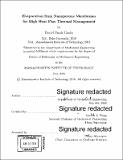| dc.contributor.advisor | Evelyn N. Wang. | en_US |
| dc.contributor.author | Hanks, Daniel Frank | en_US |
| dc.contributor.other | Massachusetts Institute of Technology. Department of Mechanical Engineering. | en_US |
| dc.date.accessioned | 2017-08-01T13:14:42Z | |
| dc.date.available | 2017-08-01T13:14:42Z | |
| dc.date.copyright | 2016 | en_US |
| dc.date.issued | 2016 | en_US |
| dc.identifier.uri | http://hdl.handle.net/1721.1/110889 | |
| dc.description | Thesis: Ph. D., Massachusetts Institute of Technology, Department of Mechanical Engineering, 2016. | en_US |
| dc.description | Cataloged from PDF version of thesis. | en_US |
| dc.description | Includes bibliographical references (pages 119-123). | en_US |
| dc.description.abstract | Heat dissipation is a critical limitation in a range of electronic devices including microprocessors, solar cells, laser diodes and power amplifiers. The most demanding devices require dissipation of heat fluxes in excess of 1 kW/cm2 with heat transfer coefficients more than 30 W/cm 2K. Advanced thermal management solutions using phase change heat transfer are the most promising approach to address these challenges, yet current solutions are limited due to the combination of heat flux, thermal resistance, size and flow stability. This thesis reports the design, fabrication and experimental characterization for an evaporation device with a nanoporous membrane for high heat flux dissipation. Evaporation in the thin film regime is achieved using nanopores with reduced liquid film thicknesses while liquid pumping is enhanced using the capillary pressure of the 120 nm pores. The membrane is mechanically supported by ridges that form liquid supply channels and also serve as a heat conduction path to the evaporating meniscus at the surface of the membrane. The combination of high capillarity pores with high permeability channels facilitates theoretical critical heat fluxes over 2 kW/cm2 and heat transfer coefficients over 100 W/cm2K. Proof-of-concept devices were fabricated using a two-wafer stack consisting of a bonded silicon-on-insulator (SOI) wafer to a silicon wafer. Pores with diameters 110 - 130 nm were defined with interference lithography and etched in the SOI. Liquid supply microchannels were etched on a silicon wafer and the two wafers were fusion bonded together to form a monolithic evaporator. Once bonded, the membrane was released by etching through the backside of the SOI. Finally, platinum heaters and Resistive Temperature Detectors (RTDs) were deposited by e-beam evaporation and liftoff to heat the sample and measure the device temperature during experiments, respectively. Samples were experimentally characterized in a custom environmental chamber for comparison to the model using R245fa, methanol, pentane, water and isopropyl alcohol as working fluids. A comparison of the results with different working fluids demonstrates that transport at the liquid-vapor interface is the dominant thermal resistance in the system, suggesting a figure of merit: ... The highest heat flux recorded was with pentane at ... and the highest heat transfer coefficient recorded was with ... not including the substrate resistance. However, the samples were observed to clog with soluble, nonvolatile contaminants which limited operation to several minutes. The clogging behavior was captured in a mass diffusion model and a new configuration was suggested which is resistant to clogging. Evaporation from nanopores represents a new paradigm in phase change cooling with a figure of merit that favors high volatility, low surface tension fluids rather than water. The models and experimental results validate the functionality and understanding of the proposed approach and provide recommendations for enhancements in performance and understanding as well as strategies for resistance to clogging. This work demonstrates that nanoporous membranes have the potential for ultra-high heat flux dissipation to address next generation thermal management needs. | en_US |
| dc.description.statementofresponsibility | by Daniel Frank Hanks. | en_US |
| dc.format.extent | 123 pages | en_US |
| dc.language.iso | eng | en_US |
| dc.publisher | Massachusetts Institute of Technology | en_US |
| dc.rights | MIT theses are protected by copyright. They may be viewed, downloaded, or printed from this source but further reproduction or distribution in any format is prohibited without written permission. | en_US |
| dc.rights.uri | http://dspace.mit.edu/handle/1721.1/7582 | en_US |
| dc.subject | Mechanical Engineering. | en_US |
| dc.title | Evaporation from nanoporous membranes for high heat flux thermal management | en_US |
| dc.type | Thesis | en_US |
| dc.description.degree | Ph. D. | en_US |
| dc.contributor.department | Massachusetts Institute of Technology. Department of Mechanical Engineering | |
| dc.identifier.oclc | 994209313 | en_US |
